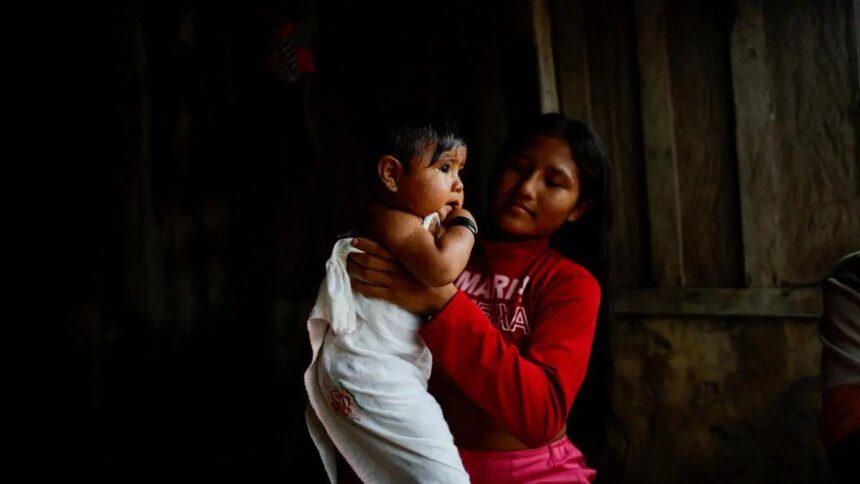Deep in the Amazon, Indigenous women express profound anxiety about potential pregnancies. Rivers, once vital to their existence, now transport mercury from illegal gold mining operations, jeopardizing the health of their unborn children.
“Breast milk is no longer reliable,” stated Alessandra Korap, a leader of the Munduruku people.
In Sai Cinza, a Munduruku community enveloped by illegal mines, the family of three-year-old Rany Ketlen grapples with her inability to raise her head and her struggles with muscle spasms.
Scientists might soon provide answers. Rany is among at least 36 individuals in the area, primarily children, experiencing unexplained neurological disorders, as highlighted by preliminary data from pioneering research into mercury contamination impacts.
While experts have warned about the dangers mercury poses to Indigenous children in the Amazon, no study has established a definitive causal link to disabilities within these communities—an assertion that this upcoming study may solidify.
EAT THE FISH POISONED BY MERCURY OR GO HUNGRY
Rany’s father, Rosielton Saw, has worked as a miner near their village for years, following in his father’s footsteps.
Seated in the family’s modest one-bedroom wooden home, Rosenildo acknowledged the danger of the mercury used in their mining activities.
However, mining approximately 30 grams of gold per week provides just enough sustenance for the family, he explained.
They regularly consume surubim, a carnivorous fish that accumulates mercury within the river ecosystem. Rany, who has severe swallowing issues, consumes fish broth.
In recent years, government health officials have reported numerous other cases in the broader region of individuals suffering from similar disorders. A lack of testing and medical access has hindered the establishment of a comprehensive understanding of the situation.
Currently, researchers are gathering data on neurological problems commonly linked to mercury poisoning, including severe brain malformations and memory issues, in a long-term study expected to conclude by the end of 2026.
The scientists involved in this unpublished research, supported by Brazil’s leading public health institute, have identified mercury leaking into waterways as a significant concern. Miners use mercury to bind minute gold particles extracted from riverbanks—a largely unregulated trade stimulated by soaring gold prices.
The mercury has contaminated river fish, a dietary staple for Indigenous communities, and has accumulated in women’s placentas, breast milk, and offspring at alarmingly elevated levels, frequently exceeding the hazardous threshold for pregnant mothers by two to three times.
Chief Zildomar Munduruku, who also serves as a nurse, articulated the dilemma: he cannot instruct his people to stop consuming fish, despite official health advisories. “If we obey their rules, we will go hungry,” he said.
EVEN IF MINING STOPS, MERCURY WILL LINGER
Downstream from Sai Cinza, diplomats and world leaders are scheduled to convene next month in the Amazon for the United Nations climate summit, COP30. Brazilian organizers have dubbed it the “Forest COP,” spotlighting threats to tropical rainforests and their inhabitants, including illegal mining activities across the region.
Brazilian President Luiz Inacio Lula da Silva has expelled thousands of miners from Indigenous territories since resuming office in 2023. However, the mercury residue cannot decompose as it cycles through air, water, and soil, perpetuating a long-term health emergency.
According to the Health Ministry, Brazil’s government has amplified monitoring mercury levels in the Munduruku Indigenous Territory, trained public health officials to identify early signs of mercury poisoning, and invested in clean water resources for remote communities.
Even if gold mining in the Amazon were to cease entirely, the deposited mercury would persist for many more decades, noted Paulo Basta, a researcher at the public health institute Fiocruz, who has studied mercury contamination among Indigenous populations for over 30 years.
Documents, interviews, and recent data reviewed by Reuters indicate that the humanitarian crisis triggered by illegal mining will have lasting repercussions for current and future generations of Indigenous communities in the Amazon.
A 2021 study by Basta and his colleagues revealed that 10 of 15 mothers tested in three Munduruku villages exhibited elevated mercury levels. An earlier study found that 12 of 13 individuals in a Yanomami village heavily affected by mining had perilously high mercury levels. Nearly all of the 546 registered cases documented in government databases by March 2025 were compiled by Basta and his team.
“That’s just the tip of the iceberg,” Basta stated. The Munduruku, Yanomami, and Kayapó territories harbor tens of thousands of individuals who could potentially suffer from mercury contamination.
PROVING CAUSATION IS NOT EASY
Basta’s team aims to furnish a crucial link in establishing proof that mercury exposure is causing disabilities. To achieve this, they are tracking 176 pregnant women and monitoring their infants during the first years of life.
In Sai Cinza, where Rany Ketlen resides, the preliminary data indicated that, on average, mothers in the study exhibited mercury levels five times higher than what the Brazilian Health Ministry deems safe, with their infants showing levels three times higher. Rany’s one-year-old sister, Raylene, is among those affected, although she has yet to exhibit any symptoms.
“This mercury disease, if it is not actively searched for, remains undetected,” emphasized Cleidiane Carvalho, a nurse who has been instrumental in connecting researchers with Indigenous children facing health issues. Without such research, she fears this crisis may be “silenced and neglected forever.”
However, establishing a causal link to mercury contamination has proven to be complex.
Fiocruz researchers observed that Indigenous communities often lack essential health services and are susceptible to various infectious diseases, which can also contribute to neurological disorders. Higher rates of consanguineous marriages, common in small Indigenous communities, can lead to genetic disorders.
While mercury may contribute to the conditions observed in the 36 patients without inherited genetic disorders, other factors cannot be dismissed, according to geneticist Fernando Kok from the University of São Paulo, who is collaborating on the Fiocruz study.
Tests identifying mercury in individuals provide only a glimpse of a patient’s recent dietary habits and do not conclusively prove prior exposure as a cause of neurological issues.
“It’s a perfect crime because it leaves no signature,” Kok remarked.










